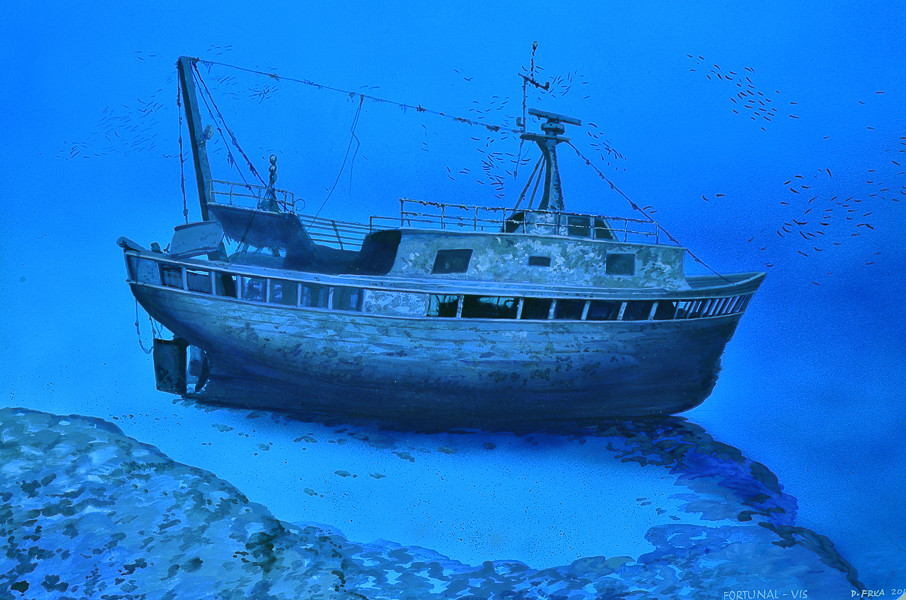
FISHING BOAT FORTUNAL
DEPTH: 37 - 51 m
SKILL: Expert
Fortunal; fishing boat; Croatia
Built: 1955 Fano, Italy
Sunk: 10th April 1997 (crashed into rocks, helmsman fell asleep)
Dimensions: l=19.7 m, w=about 4 m, h=about 1.8 m
Coordinates: 43.07093° N, 16.08522° E
Location: Bay of Tvrdo Zalučje, northern side of the island of Vis
Access: 2/5 access is solely by boat (the location is along the shore, but the terrain is inaccessible)
Visibility: 5/5 mostly excellent
Current: 5/5 mostly weak
Flora and fauna: 4/5 varied life on and around the wreck, occasionally specimens of large fish
HISTORY:
The Fortunal was a fishing boat exactly like hundreds of similar boats which with their trawling nets would furrow through the muddy sea bottom of the Adriatic every night. Built back in 1955 in the town of Fano in Italy, it was made of wood, with a relatively low and compact central superstructure and with a large rear crane for nets. The region north of Vis is rich in fish and is suitable for trawling because there are not many “zadiva” - places where fishing nets can get tangled.
According to the narratives of members of the crew, the Fortunal returned from all-night fishing south-west of Vis on the morning of 10th April 1997. The stern net was pulled in and folded, and the tired crew dozed-off after a gruelling night trawling and sorting fish. Only the monotonous lulling beat of the diesel engine could be heard, and the cosy warmth of the wooden cabin slowly rocked the free members of the crew to sleep. At the helm only the helmsman remained awake, and he only occasionally needed to keep an eye ahead because the autopilot faithfully completed the miles and to watch if it drives the plotted course towards the entrance to the harbour of Vis. Comfortably reclining in the chair next to the wheel, he finally fell fast asleep. The boat continued on without supervision, guided by the autopilot. It was exactly at 1000 hrs. when the helmsman was woken by a strong bang and powerful crash. The Fortunal with its bow had crashed into the cape of the cove at full speed, about half a mile west of the cove of Oključna. Through a considerable hole on the underside section of the bow, the boat quickly began to fill with water. The giddy crew who flew onto the deck could do nothing. Everywhere there were steep cliffs, without any shallower areas where they could try to beach the boat. Very quickly they found themselves in the sea. Fortunately, the coast was just 10 metres away so all the crew swam to the land without any great problem.
WRECK CONDITION AND DIVING:
The Fortunal sank at a point where the cape, just a few metres from the shore, turns into an underwater vertical wall which falls all the way down to a depth of 40 metres. Diving down immediately along the edge of the wall very quickly in the clear sea we see the light sandy bottom at about fifty metres deep and on it, as though placed by some hand, the wreck of the Fortunal as it lies sloping on its left side. The depth below the bow is 52 metres, and visibility is excellent as though on the surface. The wreck is attractive because of its relatively small dimensions and the possibility for orientation at every moment. The bow of the wreck is turned away from the cape, which is a sign that the ship turned around before it disappeared forever from the surface. The Fortunal is an excellent location where you can follow the process of the decay of a wooden boat in the sea.
Years ago the boat looked perfect: the hull was still quite solid and compact, everything was in situ as though the boat was afloat. However, years under the sea have made their mark. The worm Teredo navalis which lives in these warm waters has unceasingly eaten away at the wooden parts of the boat and so its structure has quickly weakened. The railings and longitudinal battens from the sides have slowly fallen off, and recently the whole fore section of the superstructure has collapsed on the right side. The wheelhouse has opened up and so now it is easy to enter inside. Around the wreck are usually shoals of fish which permanently swim close by. The mast with its antennae has fallen diagonally across the superstructure, and only the aft section of the hull resists time. But not for long, because the process of the decomposition of the wood rapidly continues and soon all that will remain of this beautiful boat on the white sand will be the engine and other metals parts, whilst everything that is wooden will irretrievably disappear. Therefore whilst the Fortunal is still largely intact, everyone should visit this site, record it and so document a time which will not return.
After a visit to the wreck whilst rising to the surface with body decompression, we can follow the shore towards the bottom of the cove where at a few metres’ depth a narrow system of attractive caves stretches out. Due to the large number of divers who pass here daily, air collects in pockets in the vaults of the caves, so that it is possible to pop your head up and talk. The bottom of the caves is stony so with careful motions and without too much movement of fins, the crystal clear sea of the final part of the dive can be enjoyed.
The description and illustrations are a courtesy of Danijel Frka and Jasen Mesić. Buy the whole book here: https://shop.naklada-val.hr/product_info.php?products_id=561
Built: 1955 Fano, Italy
Sunk: 10th April 1997 (crashed into rocks, helmsman fell asleep)
Dimensions: l=19.7 m, w=about 4 m, h=about 1.8 m
Coordinates: 43.07093° N, 16.08522° E
Location: Bay of Tvrdo Zalučje, northern side of the island of Vis
Access: 2/5 access is solely by boat (the location is along the shore, but the terrain is inaccessible)
Visibility: 5/5 mostly excellent
Current: 5/5 mostly weak
Flora and fauna: 4/5 varied life on and around the wreck, occasionally specimens of large fish
HISTORY:
The Fortunal was a fishing boat exactly like hundreds of similar boats which with their trawling nets would furrow through the muddy sea bottom of the Adriatic every night. Built back in 1955 in the town of Fano in Italy, it was made of wood, with a relatively low and compact central superstructure and with a large rear crane for nets. The region north of Vis is rich in fish and is suitable for trawling because there are not many “zadiva” - places where fishing nets can get tangled.
According to the narratives of members of the crew, the Fortunal returned from all-night fishing south-west of Vis on the morning of 10th April 1997. The stern net was pulled in and folded, and the tired crew dozed-off after a gruelling night trawling and sorting fish. Only the monotonous lulling beat of the diesel engine could be heard, and the cosy warmth of the wooden cabin slowly rocked the free members of the crew to sleep. At the helm only the helmsman remained awake, and he only occasionally needed to keep an eye ahead because the autopilot faithfully completed the miles and to watch if it drives the plotted course towards the entrance to the harbour of Vis. Comfortably reclining in the chair next to the wheel, he finally fell fast asleep. The boat continued on without supervision, guided by the autopilot. It was exactly at 1000 hrs. when the helmsman was woken by a strong bang and powerful crash. The Fortunal with its bow had crashed into the cape of the cove at full speed, about half a mile west of the cove of Oključna. Through a considerable hole on the underside section of the bow, the boat quickly began to fill with water. The giddy crew who flew onto the deck could do nothing. Everywhere there were steep cliffs, without any shallower areas where they could try to beach the boat. Very quickly they found themselves in the sea. Fortunately, the coast was just 10 metres away so all the crew swam to the land without any great problem.
WRECK CONDITION AND DIVING:
The Fortunal sank at a point where the cape, just a few metres from the shore, turns into an underwater vertical wall which falls all the way down to a depth of 40 metres. Diving down immediately along the edge of the wall very quickly in the clear sea we see the light sandy bottom at about fifty metres deep and on it, as though placed by some hand, the wreck of the Fortunal as it lies sloping on its left side. The depth below the bow is 52 metres, and visibility is excellent as though on the surface. The wreck is attractive because of its relatively small dimensions and the possibility for orientation at every moment. The bow of the wreck is turned away from the cape, which is a sign that the ship turned around before it disappeared forever from the surface. The Fortunal is an excellent location where you can follow the process of the decay of a wooden boat in the sea.
Years ago the boat looked perfect: the hull was still quite solid and compact, everything was in situ as though the boat was afloat. However, years under the sea have made their mark. The worm Teredo navalis which lives in these warm waters has unceasingly eaten away at the wooden parts of the boat and so its structure has quickly weakened. The railings and longitudinal battens from the sides have slowly fallen off, and recently the whole fore section of the superstructure has collapsed on the right side. The wheelhouse has opened up and so now it is easy to enter inside. Around the wreck are usually shoals of fish which permanently swim close by. The mast with its antennae has fallen diagonally across the superstructure, and only the aft section of the hull resists time. But not for long, because the process of the decomposition of the wood rapidly continues and soon all that will remain of this beautiful boat on the white sand will be the engine and other metals parts, whilst everything that is wooden will irretrievably disappear. Therefore whilst the Fortunal is still largely intact, everyone should visit this site, record it and so document a time which will not return.
After a visit to the wreck whilst rising to the surface with body decompression, we can follow the shore towards the bottom of the cove where at a few metres’ depth a narrow system of attractive caves stretches out. Due to the large number of divers who pass here daily, air collects in pockets in the vaults of the caves, so that it is possible to pop your head up and talk. The bottom of the caves is stony so with careful motions and without too much movement of fins, the crystal clear sea of the final part of the dive can be enjoyed.
The description and illustrations are a courtesy of Danijel Frka and Jasen Mesić. Buy the whole book here: https://shop.naklada-val.hr/product_info.php?products_id=561

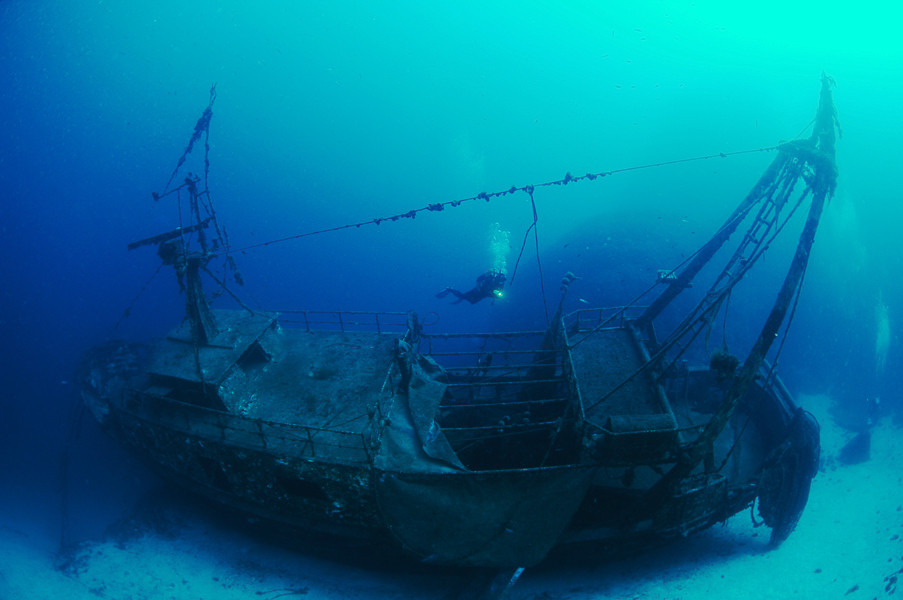
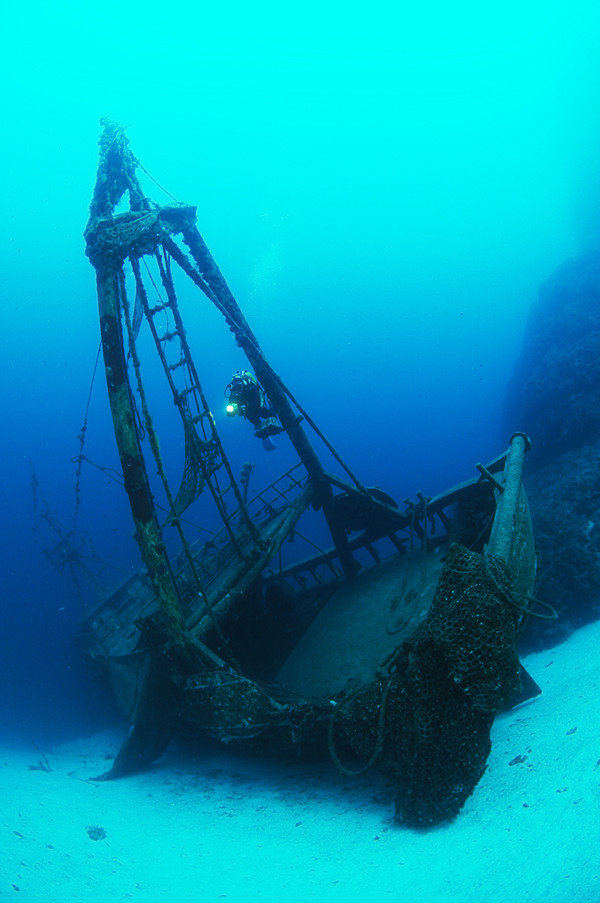
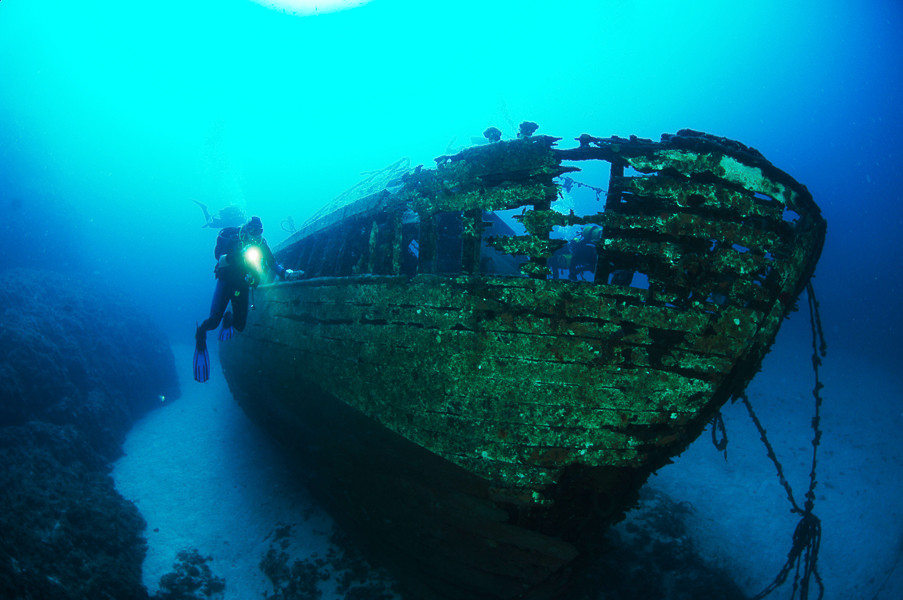

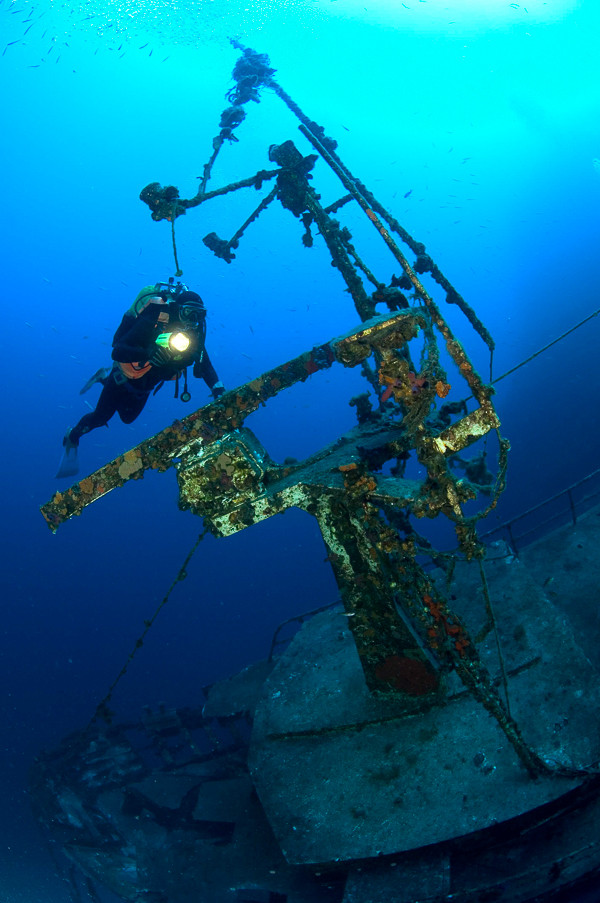
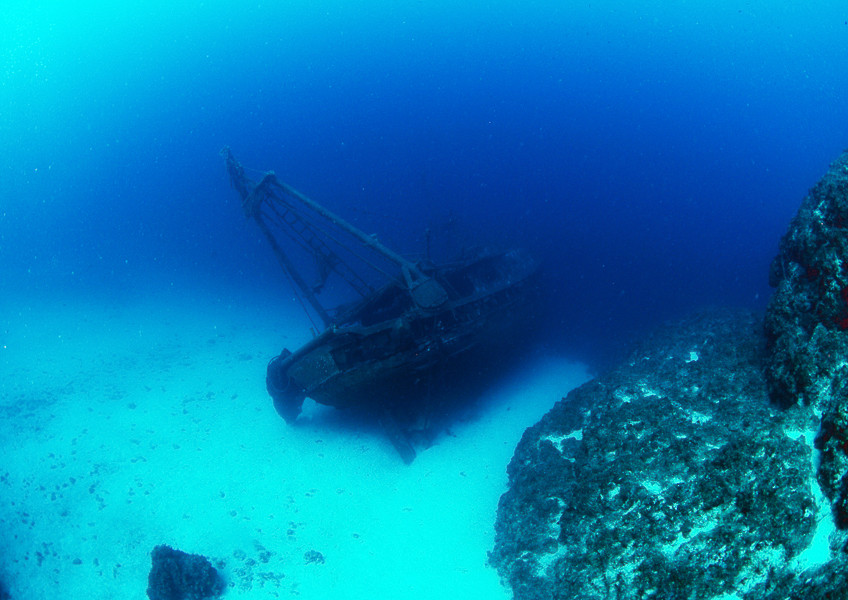

 The investment is co-financed by the Republic of Slovenia and the European Union from the European Regional Development Fund.
The investment is co-financed by the Republic of Slovenia and the European Union from the European Regional Development Fund.  H2O Globe BETA
H2O Globe BETA